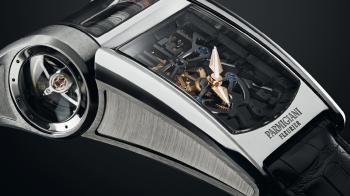This is very much a timepiece of its time, capitalising on history as it looks to the future. Parmigiani’s Bugatti Type 390, named for the legendary carmaker and the watch’s calibre number, may not be very revolutionary in terms of tourbillons, but it encapsulates the zeitgeist of its day perfectly.
There have been watches with inclined movements before – from Girard-Perregaux, MB&F, David Candaux, Phenomen, Hublot, Greubel Forsey, and Bovet, to name but a few. Cylindrical tourbillons are a rarer breed – they are notably one of the hallmarks of the Rebellion brand.
Combining a tilted movement and a cylindrical tourbillon is an especially demanding exercise. In this instance, the case of the Bugatti Type 390 comprises two parts: a tubular engine block holding the watch’s movement; and a perpendicular dial. The point where the two join is articulated, so it can be inclined at an angle of up to 12°, making it all the more comfortable to wear.
While the longstanding collaboration between Parmigiani and Bugatti dates back to 2004, it was not until the SIHH in January 2018 that the first tourbillon watch celebrating the partnership made its appearance. This timepiece was created to evoke the Bugatti Chiron, at that time the most powerful and fastest car in the world, packing 1500hp. It thus fell to Parmigiani to design a timepiece that would be a worthy tribute to the Chiron’s quad-turbocharged W16 engine.
One nod after another
The Type 390 makes several allusions to the supercar, not least the two co-axial barrels, providing an 80-hour power reserve and mounted in series, recalling the Chiron’s dual fuel tanks. Not only that, but one of the two barrels has Louis Chiron’s signature engraved on it, while the other bears the inscription Le vieux renard (‘the old fox’) in reference to the iconic driver and his nickname.
Another feature common to car and watch alike is that the proportions of the bodywork are dictated by the powerhouse. In the Type 390, they are based on the dimensions of the tourbillon regulator. The latter’s measurements were used to calculate those of the case and the movement as a whole, so as to achieve a perfect cylinder. Just as in a race car engine, the Type 390’s ‘engine’ is transverse, linked to the main dial via a perpendicular endless screw.

Highly complex construction
The calibre’s cylindrical architecture posed a great many challenges that simply don’t exist in flat movements, with their conventional gear-and-pinion transmission systems. Here, planetary gear trains are used throughout. These are vertical rather than flat, transmitting energy from one gear to the next as in a gear box. This gear system called for the smallest ball bearings in the world, just 1.28mm in diameter, with 12 ceramic bearings, each a mere 0.2mm in diameter.
The 80-hour power reserve is indicated by means of a conical toothed differential. This mechanism swivels on two guide rings; the power reserve can thus be read off on a tube with a fixed indicator (a slightly different version of the principle of the conical power reserve was to be taken up subsequently by Ferdinand Berthoud). The end result of all this is that the movement construction is extremely complex. Instead of the usual flat format, with a baseplate on which bridges are mounted, the PF390 calibre comprises seven layers, like so many vertical slices, and a total of 302 components.
Rare and distinguished
In terms of style, the Type 390 is unashamedly modernist. The barrel drums are made from titanium; the black dial is openworked. Drawing inspiration from the flowing curves of the Bugatti Chiron, there were three original versions of the model in white gold, rose gold and titanium, each with the inscription “EDITION LIMITEE 10 PIECES” engraved on the caseback.
To create this imposing timepiece, Parmigiani Fleurier enlisted its own integrated Manufacture-made ecosystem. The variable inertia balance and Breguet terminal curve hairspring are made by Atokalpa. And as Parmigiani announced in 2018, the PF390 movement went on to be used as the basis for the subsequently developed tubular tourbillons.
*This year GMT Magazine and WorldTempus have embarked on the ambitious project of summarising the last 20 years of the Tourbillon in The Millennium Watch Book - Tourbillons, a big, beautifully laid out coffee table book. This article is an extract. The Millennium Watch Book - Tourbillons is available on www.the-watch-book.com, in French and English.






